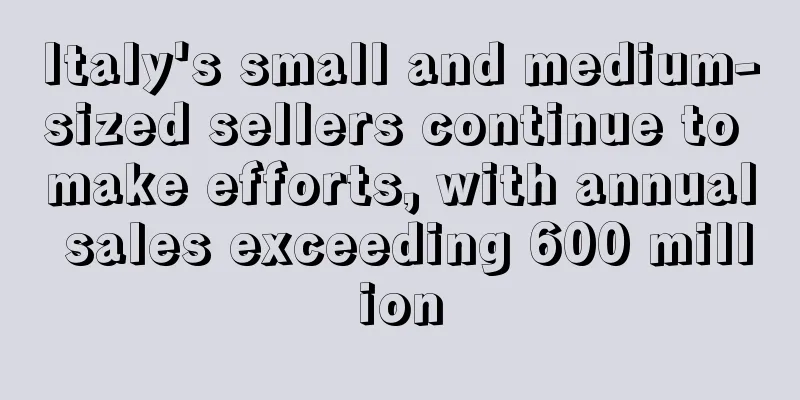Amazon commission suddenly increased? Sellers lose 70% on one order

|
Entering October also means the peak season is coming, but this year's peak season does not seem to be happy. Many sellers have been hit by a drop in orders, with the highest drop reaching nearly 70%. However, while orders have fallen, sellers' inventory capacity has risen.
When orders are not received, a series of discount sales become the seller's routine operation. However, Amazon's commission for discounted products has suddenly increased sharply, and many discounted products are charged commissions based on the list price . One seller said that he lost 70 or 80 yuan for each sale ...
Losses should not become the norm for Amazon sellers. The camp that refuses to be cross-border philanthropists is growing stronger, and a wave of resistance to price cuts is brewing wildly.
Sellers are furious. Amazon charges commission based on pre-discount price
Yesterday afternoon, a seller accidentally discovered that the commission calculation was abnormal and panicked. "Yesterday, the commission was calculated based on the discounted transaction price. That is, 20 yuan was 50% off, so only 10 yuan was counted as commission, and the commission was 10*15%=1.5 yuan. Now it is calculated based on 20 yuan, and the commission is 3 yuan. Please check the backend."
The seller is participating in affiliate marketing. Currently, both accounts are charging commissions based on the original price. The relevant data is as follows:
This is not an isolated case. Another seller also found that the commission for a promotion was deducted according to the actual transaction amount the day before yesterday, but yesterday's promotion was charged according to the original price. As sellers continued to check the backend, similar messages soon became more and more.
One seller said that yesterday his off-site commission was also calculated based on the total price. The product was priced at US$139.99, the promotional rebate was US$70, the sales revenue was $77.16 (including product tax of US$7.17), the commission rate was 17%, and he was charged US$23.8.
(Seller screenshot /click to see larger image)
According to this calculation, the seller will lose 70 to 80 yuan for each order. Strangely, on the same day, there were also off-site promotion orders that received a commission of 11.9 US dollars based on the discounted price . The seller asked the platform customer service about this, but the other party investigated for more than 20 minutes but still had no results. Another seller offered a 50% discount on the off-site promotion on the 11th, and the commission was calculated based on the original price, and he said it was a "huge loss."
The commissions for off-site promotions are abnormal, and on-site promotions are not immune.
Some sellers on the US site said that for the same product, the commission was charged according to the discounted price on the 11th, but the original price was charged on the 12th. Some sellers also said that the coupons starting from the 10th were all charged at the original price. Many people reported that orders within a day were charged at both the original price and the discounted price. One seller was even more confused. His off-site promotions were calculated at the discounted price, but the full-reduction promotions were charged at the original price.
The US site is not the only site where commissions have changed. "For my German coupons, some orders are charged the price before the coupon minus the tax. For example, if the price is 22 euros and a 2 euro coupon is used, the actual commission charged is (22-0.32)*0.15." "It's the same on the Japanese site, where the commission is calculated based on the price before the coupon discount. I didn't expect a big company like Amazon to do this."
Without any announcement or email notification, the sudden commission change caught people off guard, and sellers inevitably had negative emotions, and even thought that Amazon was secretly charging them "more money without even a notice."
The commission anomaly is a system problem and is being urgently repaired.
A large number of promotional products were suddenly charged commissions based on the original price. Some sellers thought that the commission algorithm had changed, and that the promotion was likely to be a loss-making promotion. Sellers complained that coupons cost money, and it was too unfair to charge commissions. If the commissions were also charged for clearance sales outside the site, it would be better to directly reduce the price.
A seller complained that he just found out this morning that the commission was being charged at the original price. Selling products off-site was already a loss, and now he is losing even more. He opened a case and was asked to provide the order number pending investigation. He doesn’t know if he can claim compensation.
However, some sellers believe that it is impossible for Amazon to charge the money without an official notice. It should be a display problem. After the system is repaired, the actual transaction price will be charged. Most of the customer service staff who received a large number of inquiries said that this was a system problem.
At present, some sellers have received responses to the issue of incorrect commission collection for promotional orders, the content is as follows:
"We have received a notification that due to a problem with the Amazon system, many sellers' promotional order commissions were charged incorrectly on October 12, 2021. The technicians are currently repairing it urgently. Please wait for the repair results."
A seller received commissions based on the pre-discount price for more than 200 orders. The customer service said that they had helped the seller submit the information to the relevant review team. The seller can then count all the orders and contact them for processing. After the review is passed, the overcharged commissions will be refunded. The seller was very dissatisfied: "Please fix the BUG quickly. This is too deceptive. If I hadn't discovered it, I would have lost a lot of money."
In fact, Amazon has clear regulations on sales commissions for promotional orders. For orders that include promotions, Amazon will charge a sales commission based on the total sales price after the promotion is applied. The total sales price includes the product price and all shipping, gift wrapping, or other fees. For example, if product "A" is discounted, Amazon will charge a sales commission based on the total sales price after the discount is applied. Amazon may also charge a minimum sales commission depending on the product category.
The widespread commission calculation errors this time, and Amazon's failure to promptly inform sellers whether it was an algorithm adjustment or a system problem, caused an uproar among sellers. At present, it seems that this anomaly is most likely a system failure, and sellers can continue to wait and see.
Why do sellers hold large-scale promotions at this time? Because the peak season is a good time to boost rankings and sales, and many sellers want to seize the opportunity to increase sales and make the recent sluggish orders look better.
Seller orders fell by two-thirds, but two types of products bucked the trend and exploded
Recently, many sellers reported that their orders have dropped to varying degrees, and this has happened on both the US and European sites. One seller said that his orders have dropped by two-thirds, leaving only one-third. A drop of nearly 70%, more than halved! Another seller said that he only had one order in a month.
When it comes to orders, there will always be a group of sellers who come out to "compete with each other". The regular competition is a way for sellers to make fun of themselves, but it also reflects the actual situation to a certain extent. An operator in the industry mentioned that the first thing he does when he goes to work in the morning is to check the order status, and the boss will ask about it every few days.
More feedback about recent orders from Amazon sellers are as follows:
"——Orders are like zombies, today's orders are less than half of yesterday's; ——Without orders, there is no passion to discuss anything; ——In October, orders were almost halved; ——A product used to have 50 to 60 orders a day, but now only has one order a day; ——Orders dropped again; ——Why are sales so bad? I can’t survive!”
The editor found that the feedback about the recent decline in orders seemed to have reached a new high yesterday. Many related seller groups are discussing such topics. An old seller in the industry mentioned that yesterday was Columbus Day, so it was normal to have fewer orders.
It is understood that Columbus Day is October 12 or the second Monday in October to commemorate Columbus's first landing on the American continent in 1492. This holiday was first initiated in the United States in 1792, when it was the 300th anniversary of Columbus' arrival in America. The Tammany Society in New York City initiated and held a commemorative event. In 1893, Chicago held the Columbian Exposition and held a grand commemorative event again. Since then, on this day every year, most states in the United States have held celebration parades, church services and school activities to commemorate this historic day.
Then a colleague lamented that Americans were celebrating, so who would go shopping? Perhaps this was the only way to comfort themselves! Another operator said that he had found a reason to explain the poor order to his boss.
However, the recent decline in orders also depends on the sellers themselves and the relevant categories. At present, some sellers have shown obvious signs of a rebound in orders. As a colleague said, not everyone has poor orders, and my friend's store is still booming.
According to relevant feedback and data, Halloween products and Christmas peripheral products have seen an explosion in sales during this period.
In the search keyword ranking of Amazon US site, Halloween-related products ranked first, and 4 of the top 8 rankings are related to Halloween, and Halloween-related search terms are all on the rise. Among them, Halloween decorations, Halloween outdoor decorations, Halloween women's clothing, etc. are all hot search terms. Recently, Halloween decoration products have exploded in orders. A seller also said that Halloween products have started to rise sharply since mid-September, and the performance in October is still excellent.
According to a survey by the National Retail Federation (NRF), Americans will also spend more on Halloween, with overall spending on Halloween this year increasing from $8 billion in 2020 to $10.14 billion. Americans will spend an average of $102.74 on Halloween, an increase of more than $10 from 2020. Families with children will spend $149.69, compared to just $73.57 a year ago.
The first two weeks of October are the peak shopping season for Halloween, and many people start buying related products in September. No wonder the sales of Halloween-related products have exploded recently.
In addition, Christmas-related products are also seeing an increase in sales. According to the top search keywords on Amazon , Christmas decoration products are currently ranked 35th, up 17 places. An old seller said that Christmas decoration products have already ranked 35th on Amazon and will probably enter the top 10 by the middle of this month or the end of the month.
Next, sellers of Christmas-related products can prepare for a surge in orders!
The rise and fall of Amazon sellers' sales is related to many factors. During certain time periods, orders for seasonal products and holiday products will increase significantly. If orders for non-seasonal products continue to fall, sellers should carefully look for the reasons.
When many sellers complained about the decline in orders, an industry insider bluntly said that peers with poor orders should not complain immediately, because complaining cannot change the situation. Everyone should think seriously about why the orders are poor and whether it is because their products are rubbish. Ask yourself, are you willing to use the products you sell? Do you think they are good? Product is king cannot be an empty slogan for e-commerce people. Sellers with declining orders can reflect on whether you have really made a good product.
When orders were declining, the storage capacity of many sellers surged. The logic that storage capacity would only increase if sales increased, which was previously generally accepted by sellers in the industry, seems to have been broken?
The storage capacity of multiple sellers continues to rise
The recent update on storage capacity has given many sellers a pleasant surprise, and everyone has reported that the storage capacity has increased.
When reporting the increase in storage capacity, sellers in the industry generally prefer to present it directly in terms of quantity. One seller said that the storage capacity has increased by more than 10,000, while another seller said that the storage capacity has increased by another 7,000. After the storage capacity increased, the joy of the sellers could almost be felt through the screen.
Judging from the number of reports, the inventory capacity of many sellers has increased significantly, and this increase is universal. The relevant information of sellers is as follows:
“—Kurong gave a little too much this time; ——The storage capacity has finally increased; ——Last week, 4,000 storage capacity was used up, and today it has increased by another 7,000; ——1500 more ——Storage capacity increased by 5,000; ——The storage capacity has been expanded again, and this time more than 1,000 were given.”
M, an old seller , said that many people had suffered enough from Amazon’s storage capacity restrictions before. This time, the storage capacity has finally increased, and it has been increasing for two consecutive weeks, so they can finally ship.
It is understood that this increase in storage capacity is not the first time for some sellers. In the recent almost weekly storage capacity updates, the capacity has increased two or three times in a row.
In October, a group of sellers saw the increase in Amazon's inventory capacity. At that time, one seller said, "My inventory capacity has increased by 30%, and I am worried that it will be the same as before, and it will drop again after a few days. Now, FBA must be valid for entry into the warehouse, otherwise it will be rejected or not put on the shelves after entering the warehouse."
In addition, other sellers also reported the same situation at the time. One seller with a small inventory base saw his inventory increase by 60%. At the same time, there were also cases where the inventory of new accounts increased significantly. A seller's new account originally had 3,000 inventory, but as soon as the product was launched and sales began, the inventory increased by more than 2,000.
Other sellers are confused. An IPI score of 480 is allowed to ship 4,200 units, and a score of 450 is allowed to ship 8,500 units. The order volume is only dozens per day. I really don’t understand Amazon’s inventory capacity logic.
Like this seller, Amazon's inventory capacity logic does give many industry peers headaches. Previously, many experienced sellers analyzed that Amazon's inventory capacity is basically determined by sales, that is, the better the seller's sales, the more inventory capacity the platform will give. However, some sellers whose orders are declining have also seen the good news of increased inventory capacity.
In this regard, an industry insider said that Amazon previously reduced its inventory capacity in order to make room for products in the second half of the year, and now that the Halloween and Christmas sales season has begun, the platform will gradually open up inventory restrictions. At least there will be no further reductions before February or March next year , so everyone can rest assured to ship goods.
However, while the inventory capacity of most sellers has increased, the inventory capacity of some sellers has been ruthlessly reduced. One seller said, "My IPI score is 484 points, and I was allowed to ship more than 4,300 items last month. After the National Day holiday, the inventory capacity suddenly dropped to 1,000."
Some sellers' inventory capacity has been reduced even more. One seller with a higher reduction rate reduced it by about 70% at once , and the original delivery plan had to be postponed; a seller with the same fate said that my inventory capacity suddenly exceeded more than 30,000, and many shipments were blocked. A seller whose inventory capacity was reduced seemed to explain the reason: a lot of inventory could not be sold, and it had been reduced, and the inventory capacity exceeded a lot.
In general, since October, the inventory capacity of most sellers has increased, and some sellers have increased significantly; only a small number of sellers have continued to reduce their inventory capacity. Experienced people have analyzed that inventory capacity is related to dynamic sales, which is not completely unreasonable. Sellers whose inventory capacity has been greatly reduced can try to increase dynamic sales.
Perhaps price cuts are a direct way to increase sales. Previously, due to the prevalence of low prices and fierce competition, many sellers used price cuts to stimulate orders and protect their rankings. However, after the power cuts, factors such as price increases by suppliers, rising freight costs, and high advertising costs have cut into profits, and price increases have become a must for many sellers.
Many people raise prices, sellers raise prices by 50% but sales remain unchanged
The situation of price competition in multiple categories on Amazon is changing. First, various cost pressures are rising, and second, expectations after price increases are not bad.
For many sellers, high freight costs are a huge expense this year. One seller said: "I was so upset when I saw the freight costs for June, July, August and September!" After the third quarter freight settlement, many sellers felt the same way. Fortunately, after the power restriction policy at the end of September, the ocean freight price plummeted, and the price quoted by the Meisen channel even approached 10 yuan/kg, which was halved from the peak price of nearly 30 yuan/kg in September. The freight reduction made the sellers, who had been abused for a year, breathe a sigh of relief.
But the good times did not last long. After the National Day holiday, the shipping prices rose again. The freight forwarding company Matson has raised its prices twice in a row. The current Matson quotation has returned to 20 yuan/kg, and it is expected to rise again next week. The current reasons for the increase in shipping prices include congestion at the destination port and a reduction in the number of ships.
This roller coaster ride of ocean freight prices has caused many sellers to strain their backs. They wanted to wait and see and wait for lower freight rates before shipping, but they didn't expect that the low prices were only short-lived. Sellers are very helpless. The freight rates after the holidays are even crazier than before the holidays, and they have risen again when the peak season comes.
Another cost is that more and more suppliers are raising prices. According to the editor's survey, about 60% of Amazon sellers have received price increase notices from suppliers, of which about 1/3 have increased by 10% or less, another 1/3 have increased by 30% or more, and a few sellers have increased by 50%, 70%, or even doubled. Some sellers have received price increase notices, but have not yet determined the specific increase; only 40% have not received price increase notices or "don't know".
More and more sellers have received notices of price increases, and now a new round of power restrictions has arrived. A factory in Guangdong received a notice that it must stop using electricity for production on October 12 and 13, and the wave of price increases by suppliers may continue.
Currently, most sellers have low orders, and the effect of stimulating sales with low prices is very limited. Instead, it will erode some of the profits. As costs rise, sellers are more willing to raise prices. According to the feedback from the leading sellers, the order performance is not bad after the price increase, which has led more sellers to join the price increase action.
One seller was very satisfied: "The price has increased by one dollar a day, and it has increased by 50%, but the sales volume has not dropped." Another seller said that the price has increased by 10% for two consecutive months. After all, the cost is too high.
The number of sellers who choose to raise prices is increasing, and most of the increases are within 10%. More than half of the sellers said that the price increase had little impact on orders or increased profits, and only a few sellers had both reduced orders and profits.
The situation after the price increase also depends on the category. Some sellers said that it is difficult to increase the price of products with high competition: "I sell it for $13, and I don't get any orders if I increase it by $1. I still spend $30 a day on advertising, and it is a link that has stable orders. If I adjust it back to $13, it will be back to normal, so it is not a random increase." At the same time, the deep spiral of a few sellers is also a disturbing factor for sellers to increase prices.
At present, most sellers who have raised prices have stated that they will insist on small, stable and slow increases, while some sellers will decide based on their ranking and order volume.
With freight costs rising and sales sluggish, the peak season has not started well. Sellers still need to decide whether to maintain profits or increase sales. Amazon, commission, orders |
<<: To help sellers sell, Facebook launches holiday shopping event
>>: Social commerce is booming and has become a shopping channel favored by consumers
Recommend
What is Amazon Launchpad? Amazon Launchpad Review, Features
Amazon Launchpad is a program launched by Amazon i...
What is Fiverr? Fiverr Review, Features
Fiverr is an online freelancing platform founded ...
European online fashion sales are booming in 2021, with sports fashion being the most popular
As the epidemic in Europe further improves, fashi...
Amazon joins forces with well-known brands to sue multiple sellers!
According to information disclosed on Amazon'...
Amazon backend report adds new mobile data, sellers are upset
The announcement shows that Amazon's backend ...
Dominating the overseas charts, with billions of sales! Many overseas brands are popular
In recent years, with the improvement of people&#...
What is Clearance Sale? Clearance Sale Review, Features
Advantages Comprehensive inventory cleanup; Fast c...
What is Alluvia? Alluvia Review, Features
Alluvia is a plug-and-play solution with costs co...
What is Zongheng Cross-border E-commerce Logistics? Zongheng Cross-border E-commerce Logistics Review, Features
Shenzhen Zongheng Cross-border E-commerce Logistic...
What is chitea? chitea Review, Features
chitea is dedicated to setting the standard for qu...
Consumer electronics and small electrical appliances are most popular in the Japanese e-commerce market!
Japan is one of the most developed e-commerce mar...
Are college students going to do a cross-border IPO?
If we talk about which track can attract many big...
What is Giteki? Giteki Review, Features
Japan's Radio Law clearly stipulates that all...
Official partner of the European Cup! WorldFirst joins hands with 6 major platforms to offer benefits
The European Cup is in full swing. When many cros...
What is Sandeng Supply Chain? Sandeng Supply Chain Review, Features
Sandeng Supply Chain is a professional internatio...









